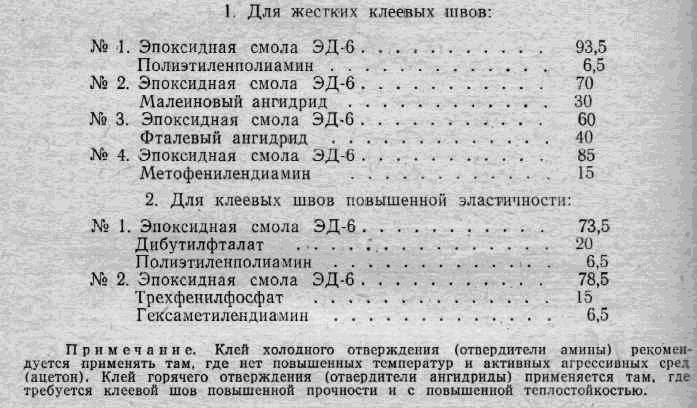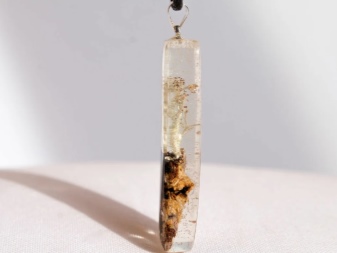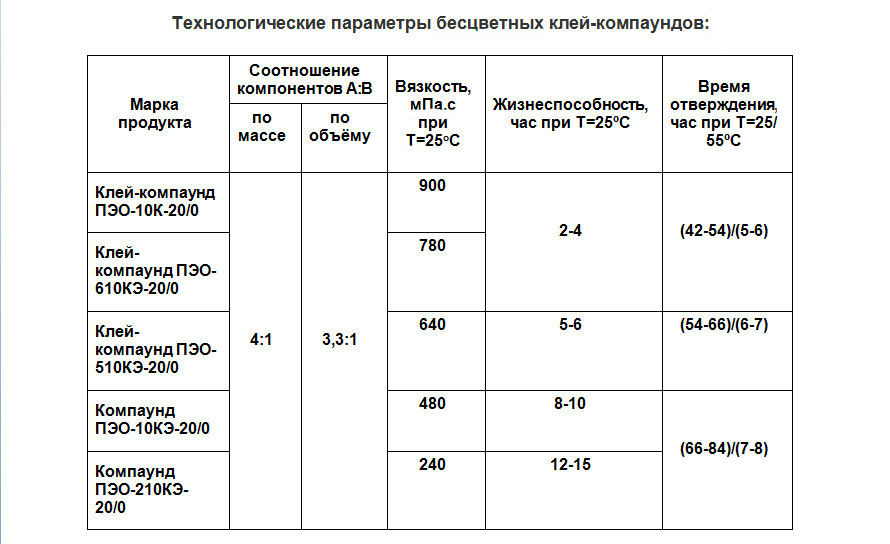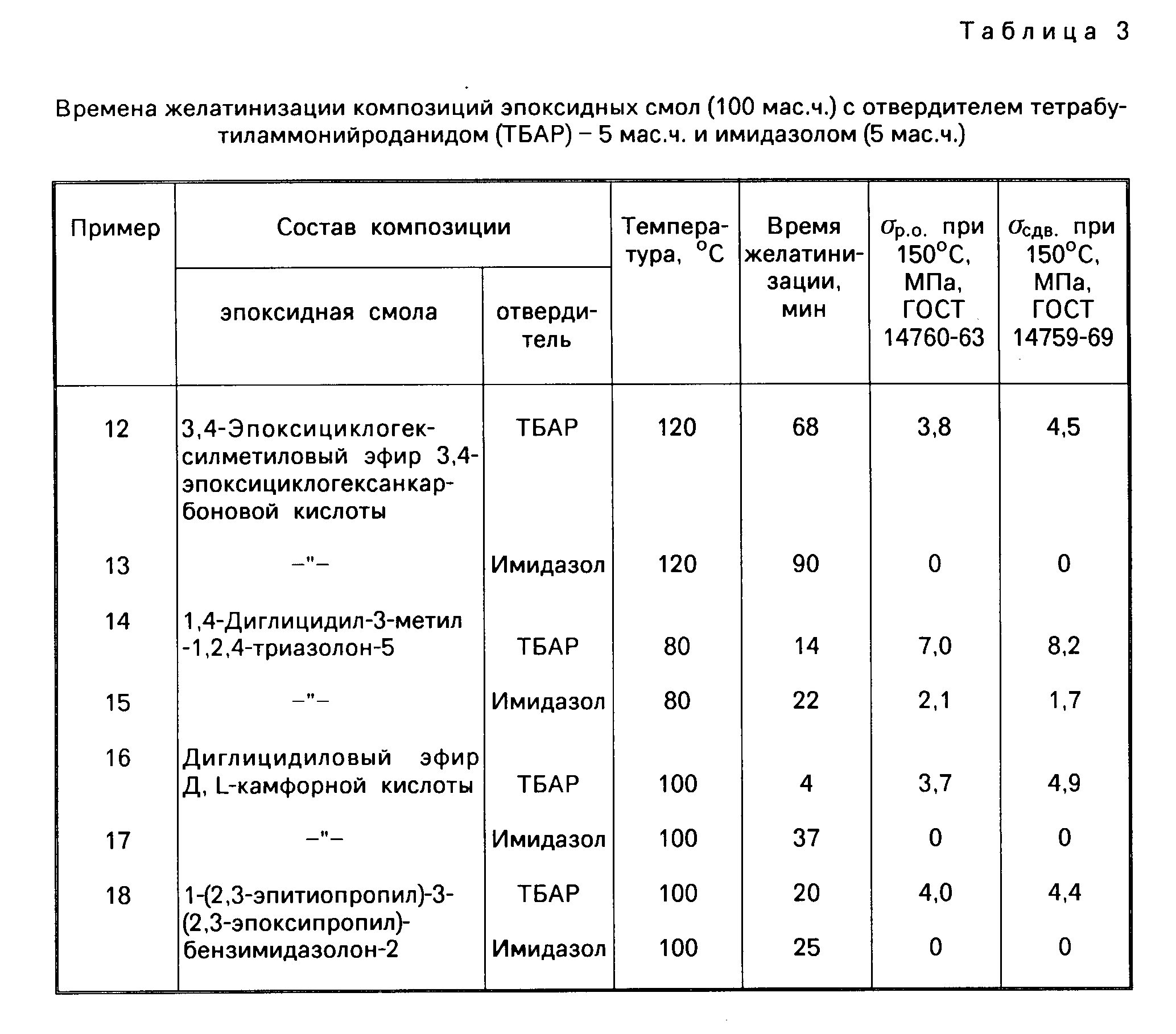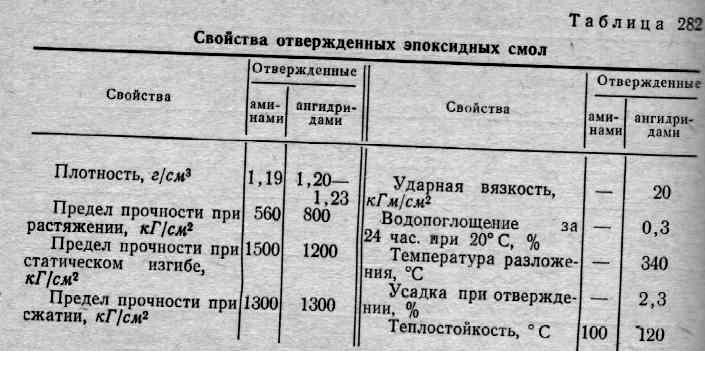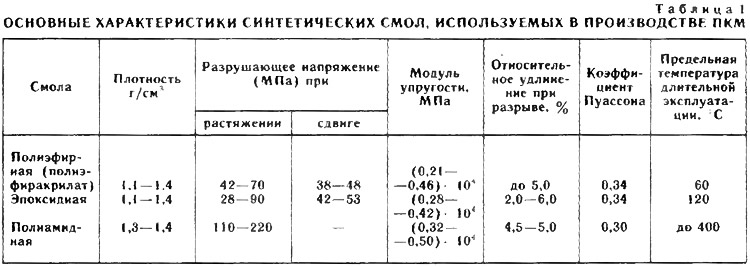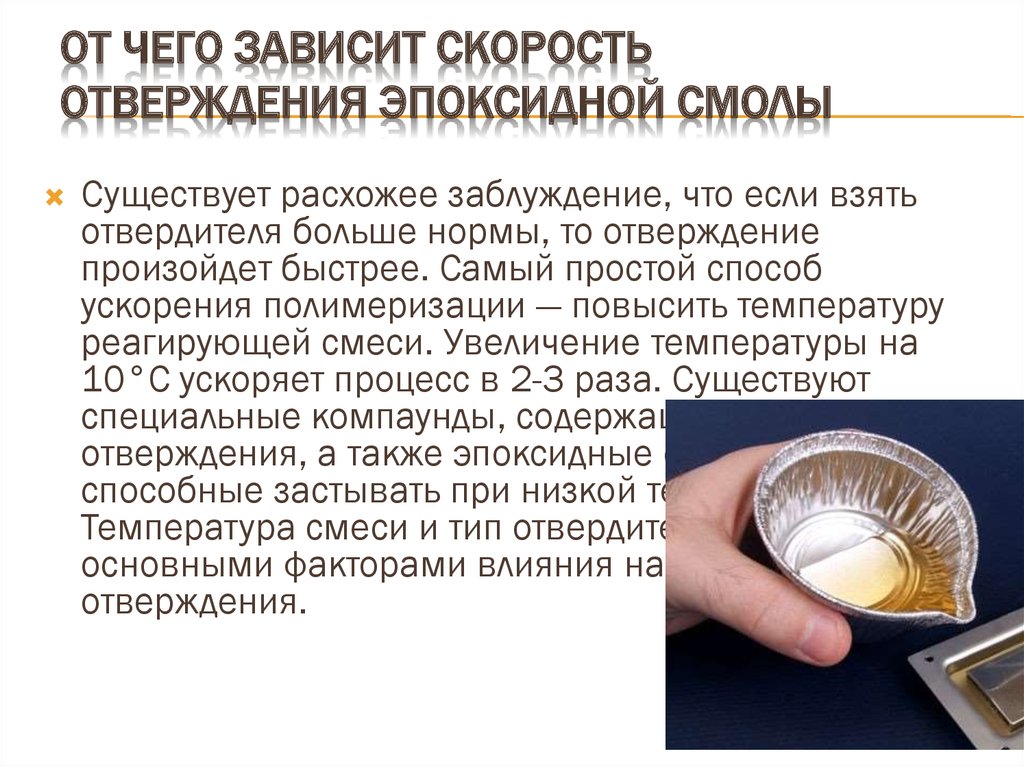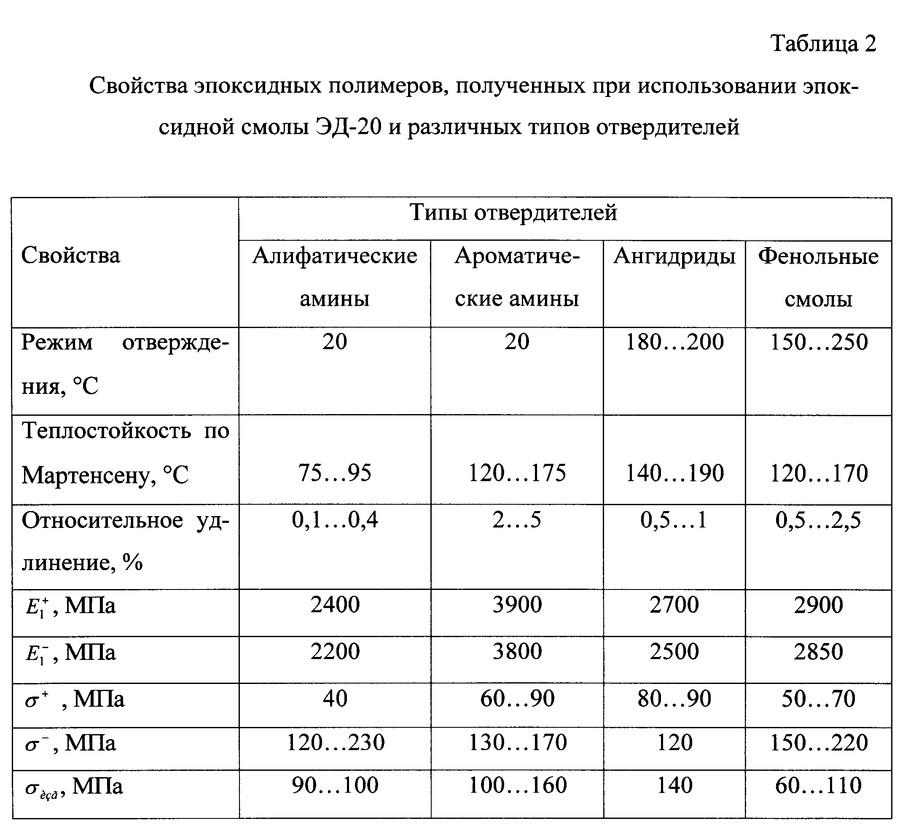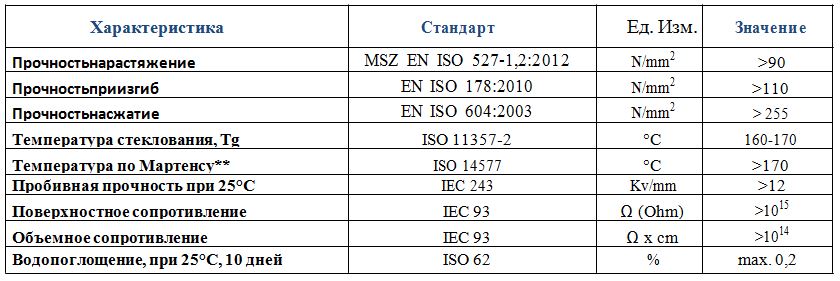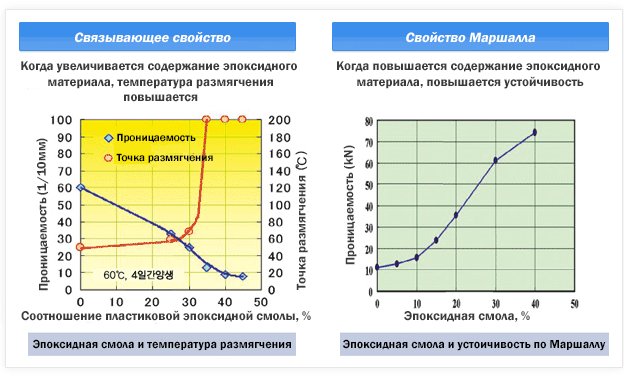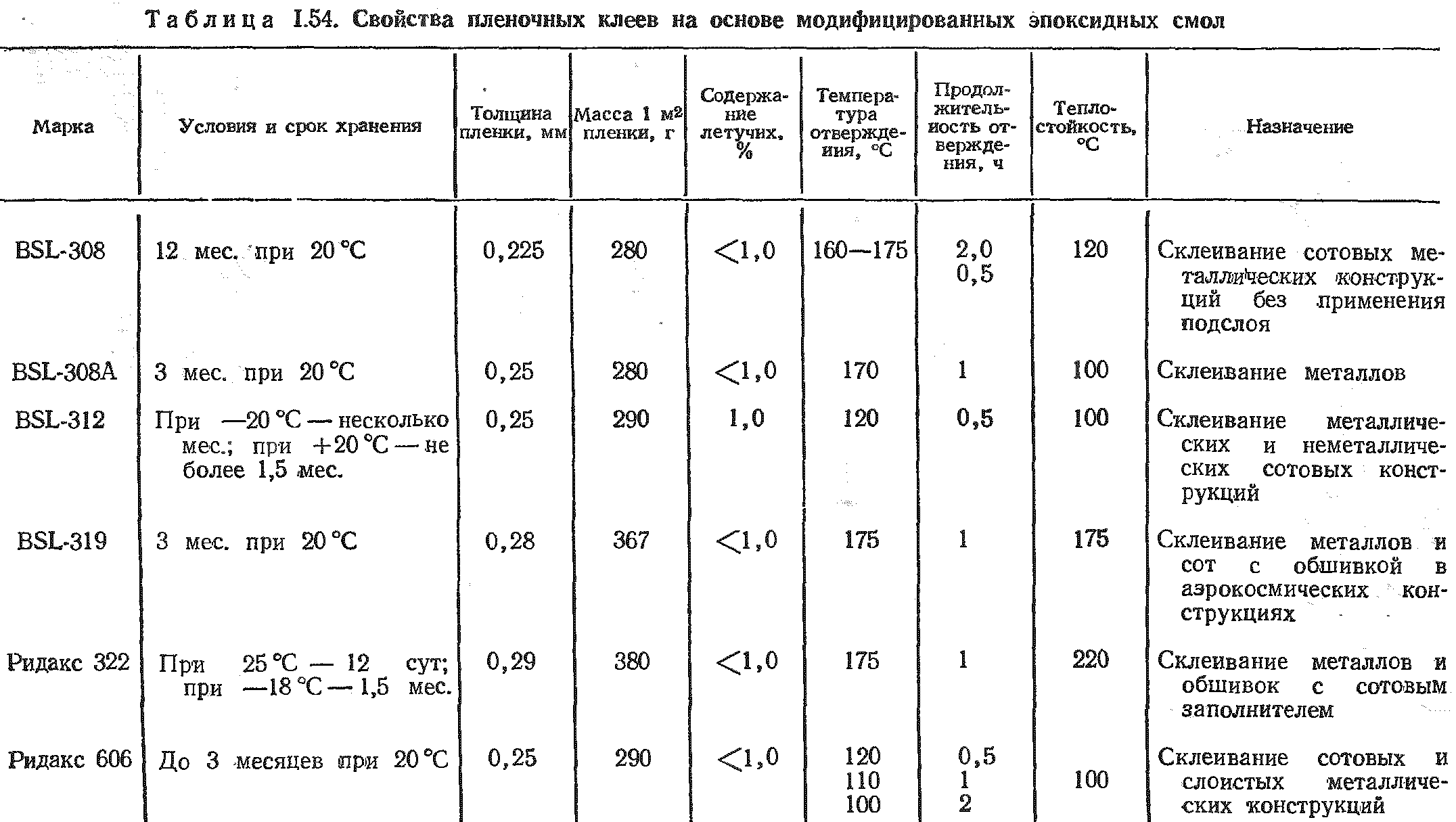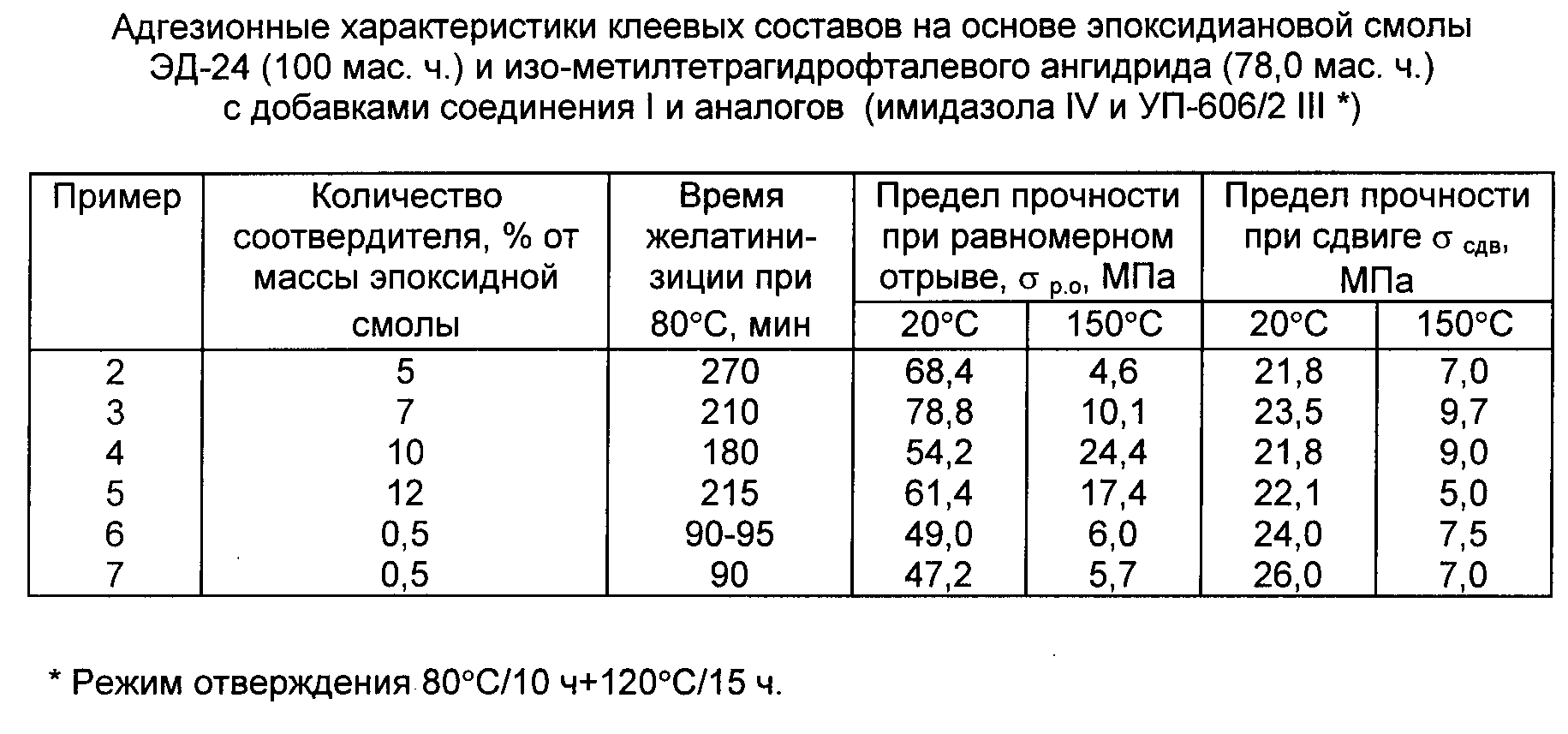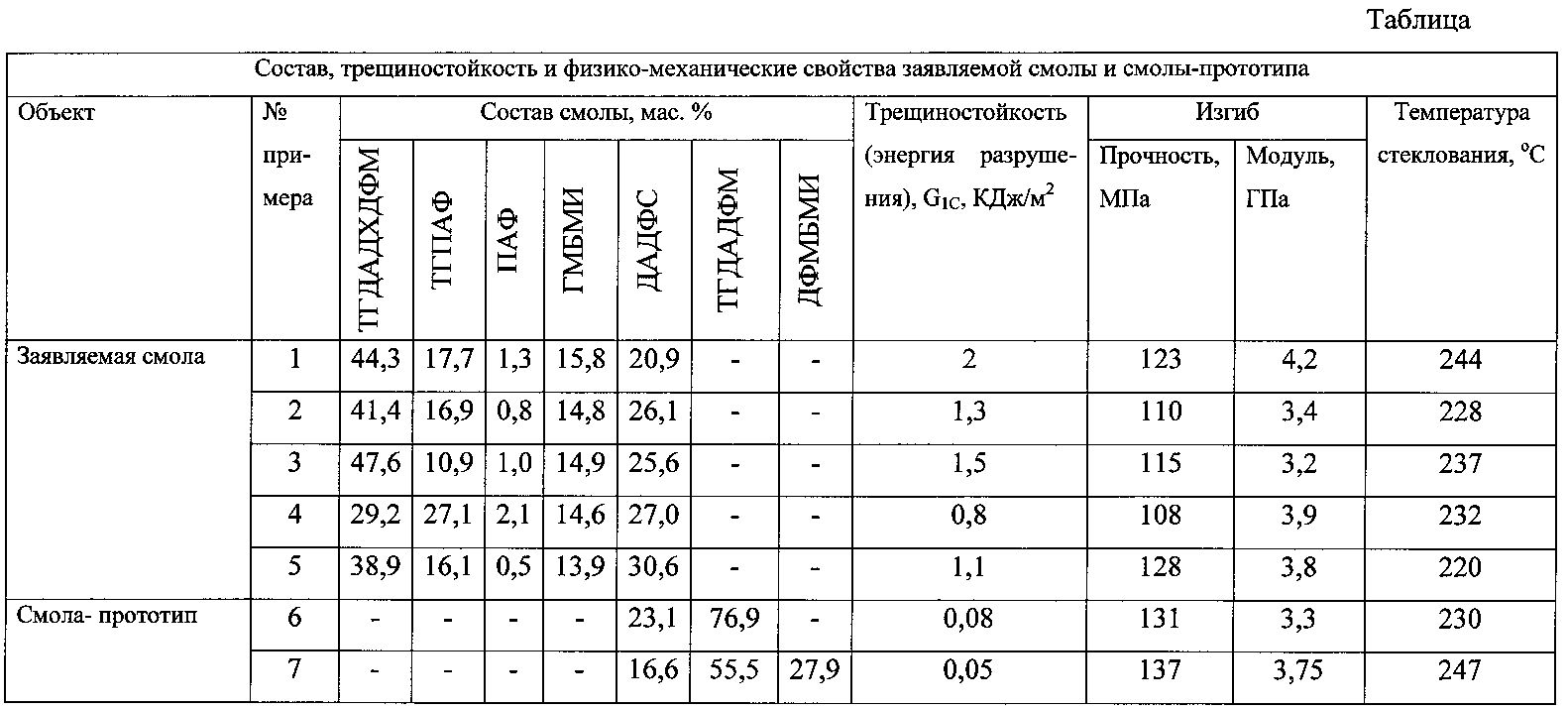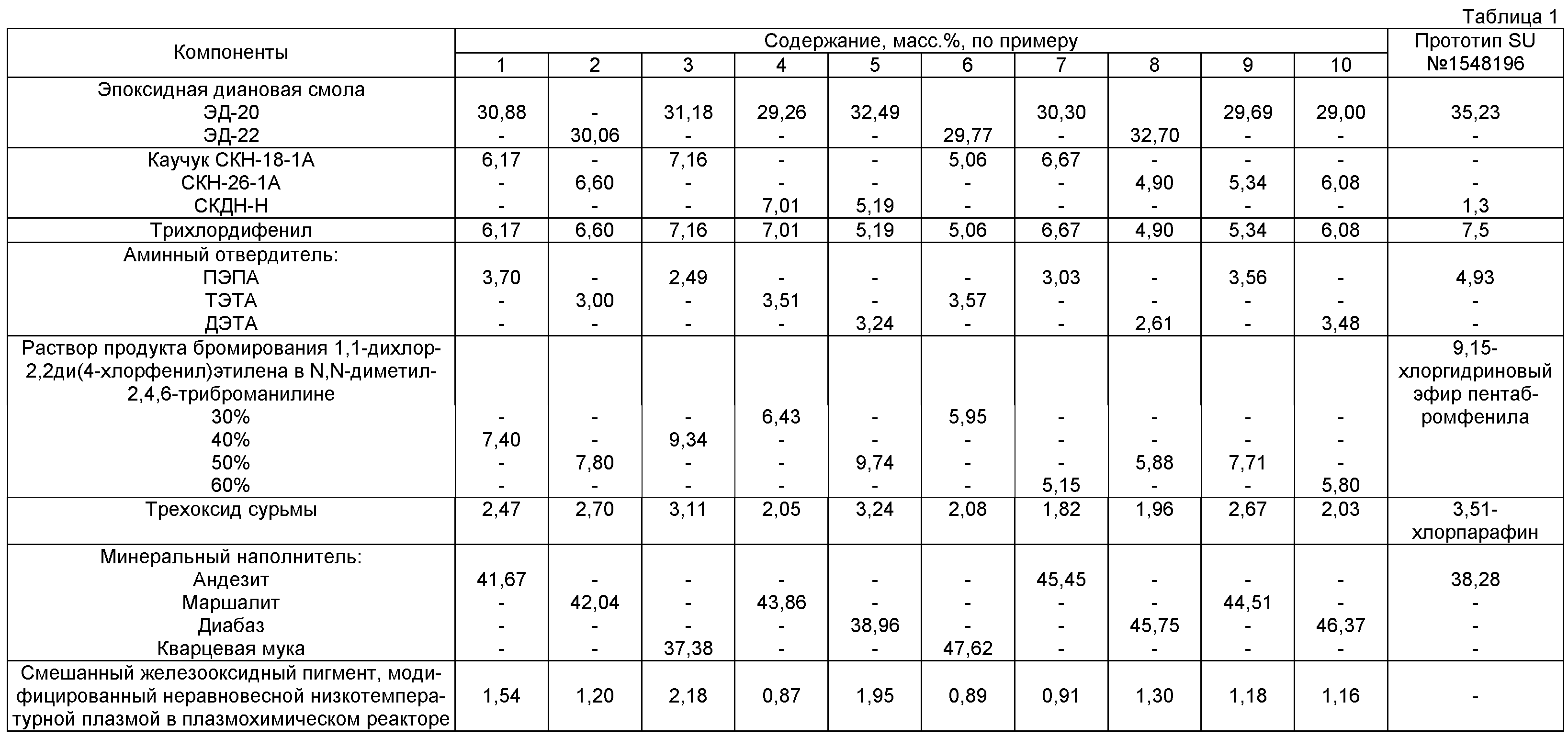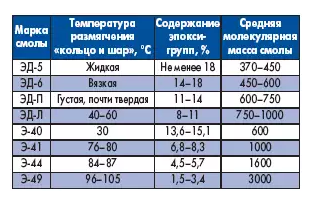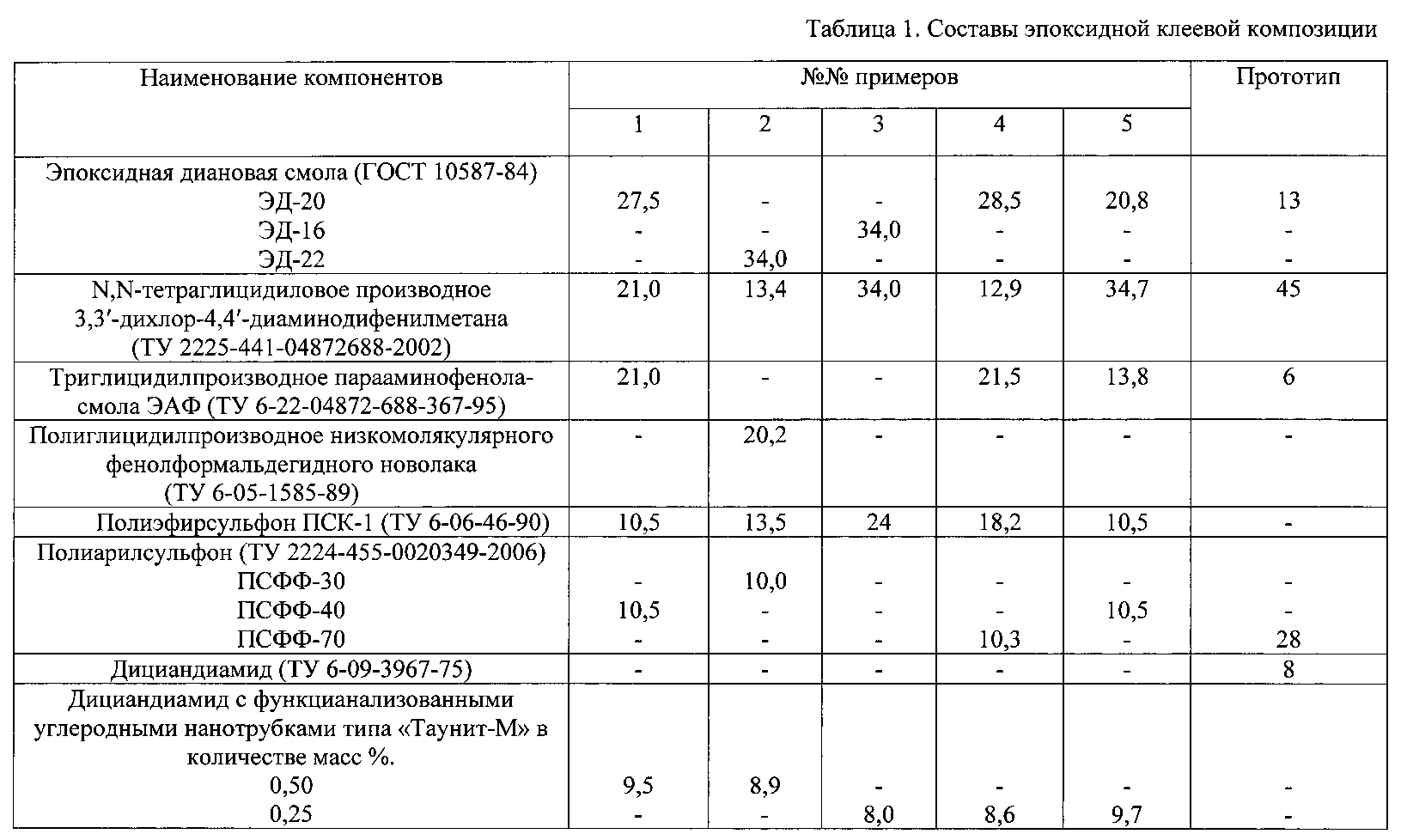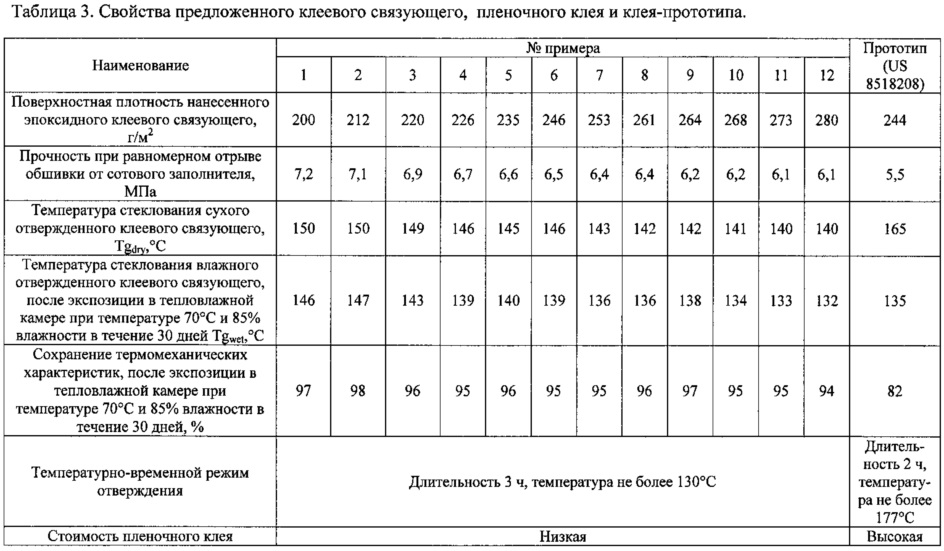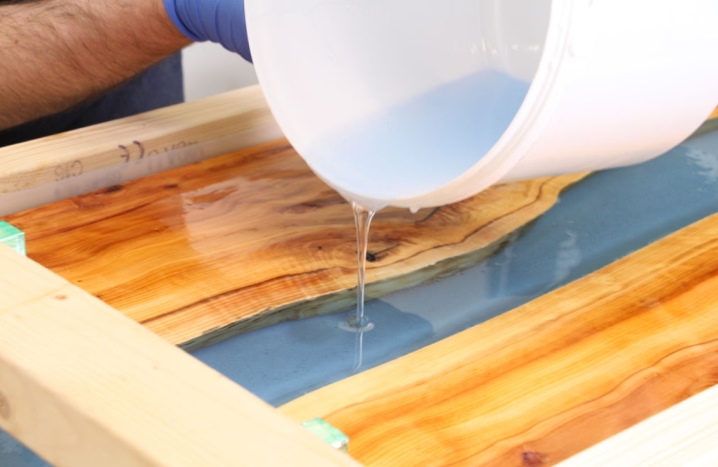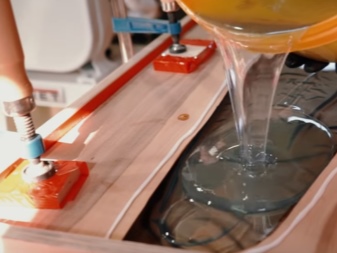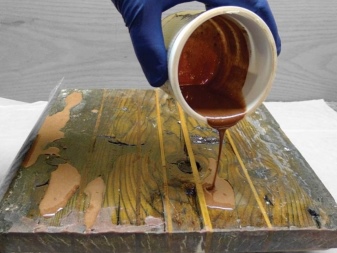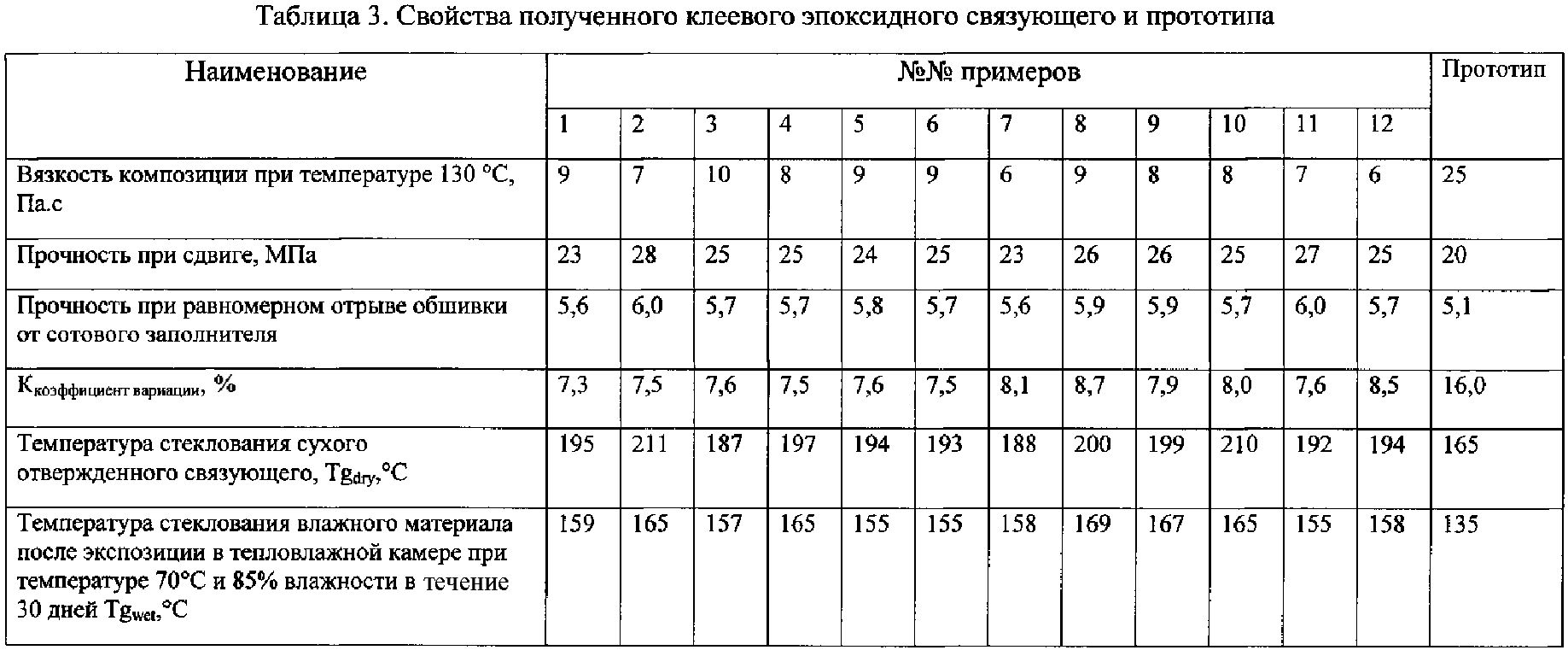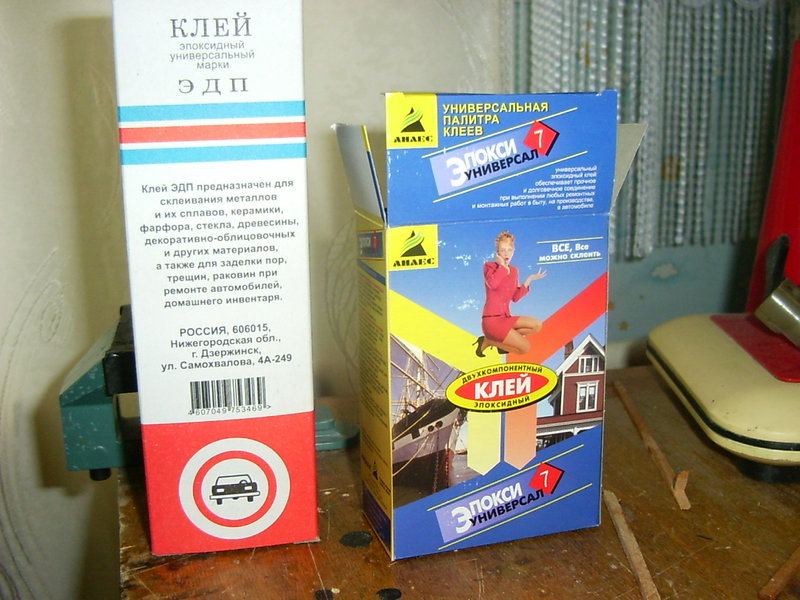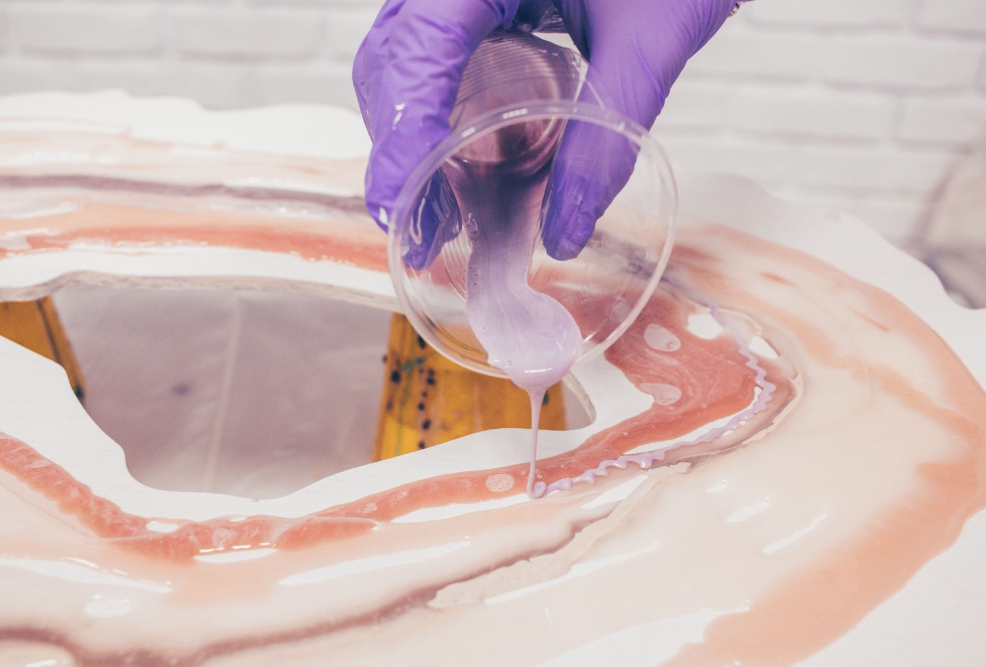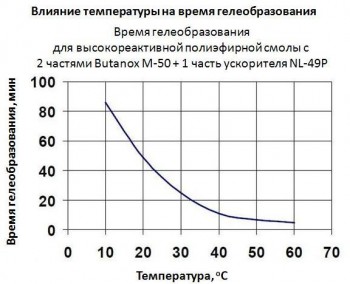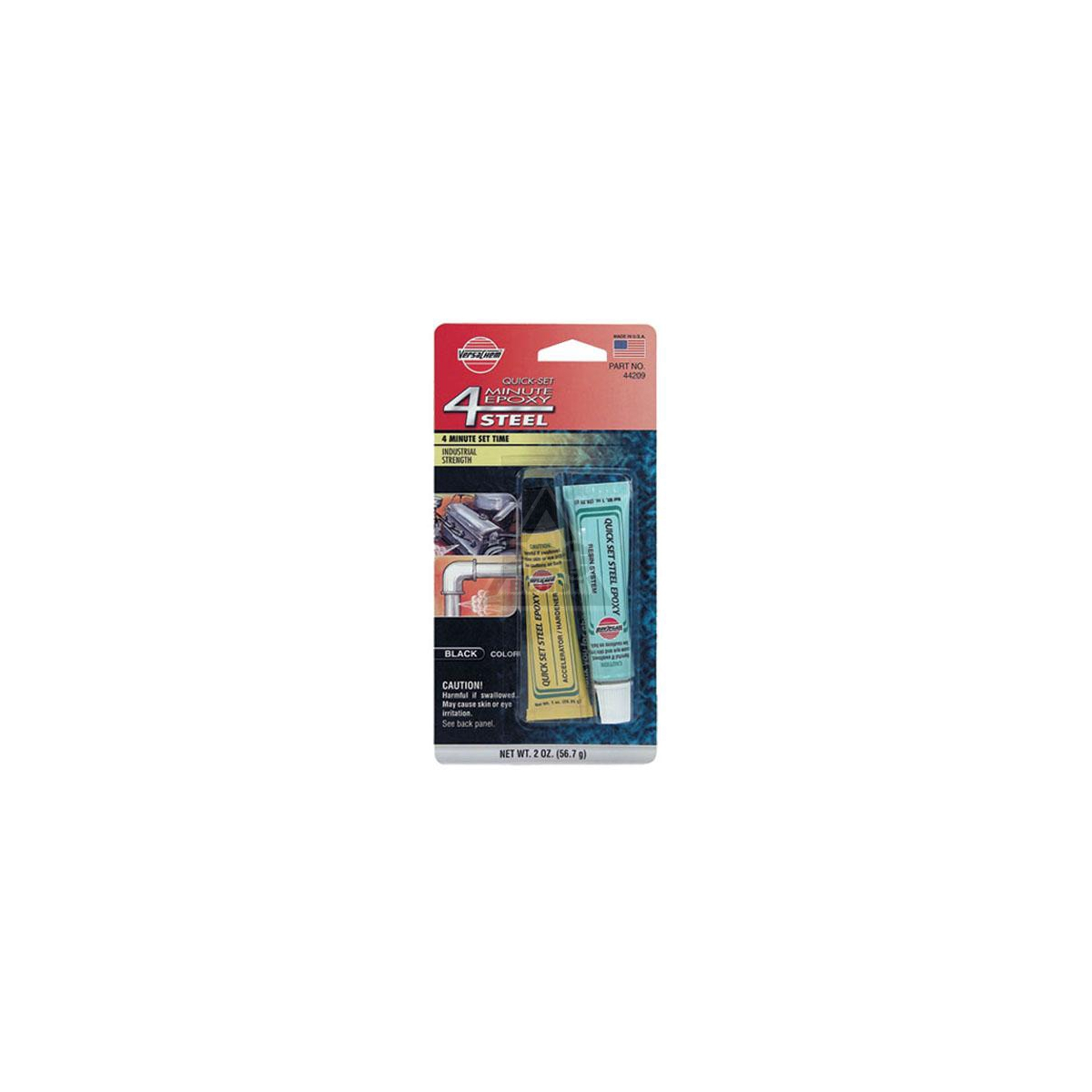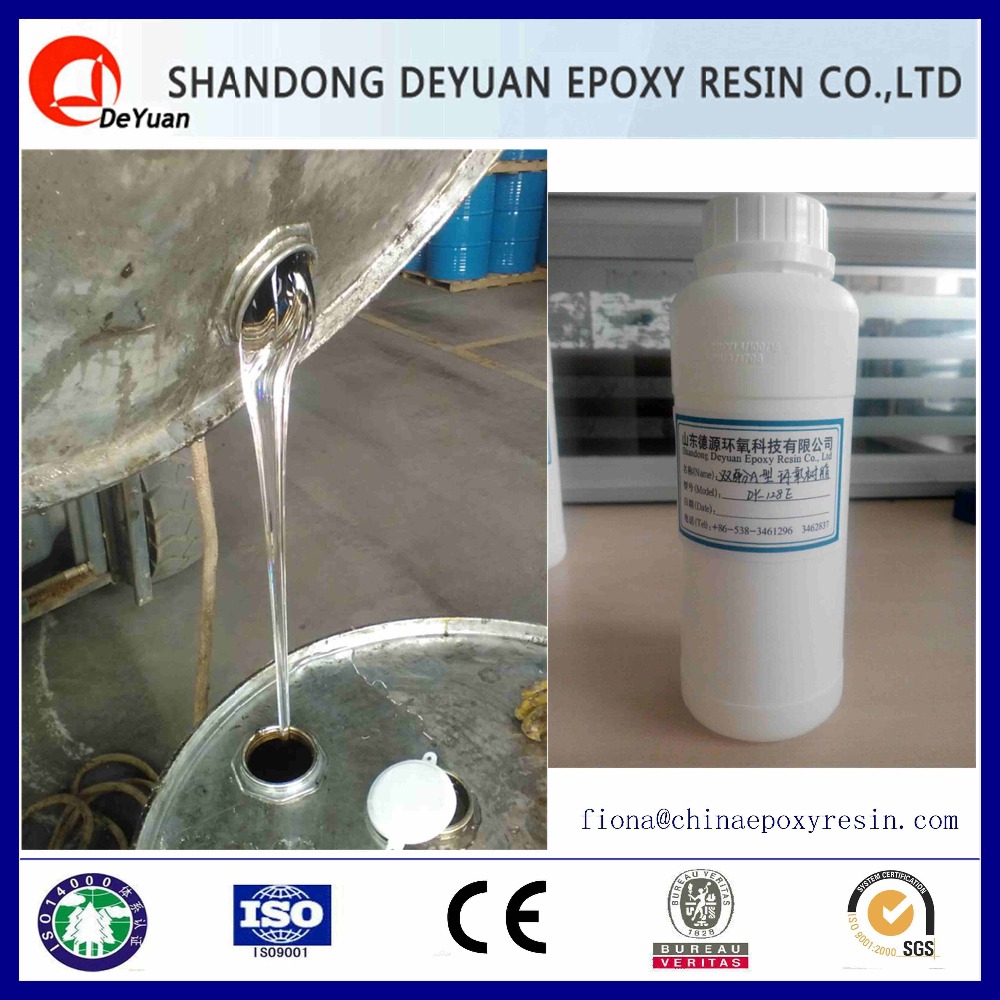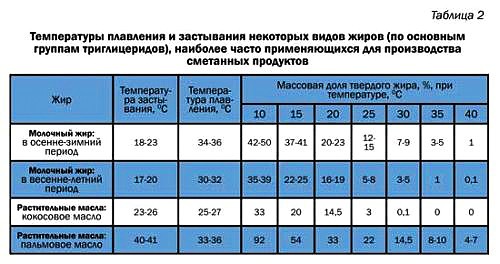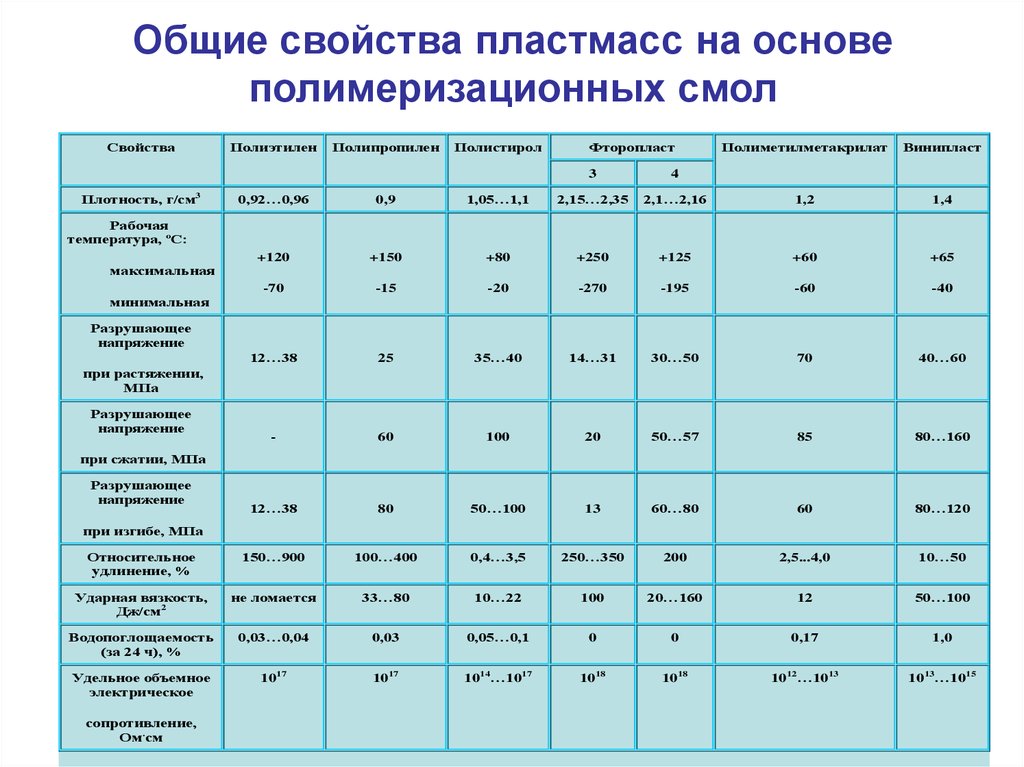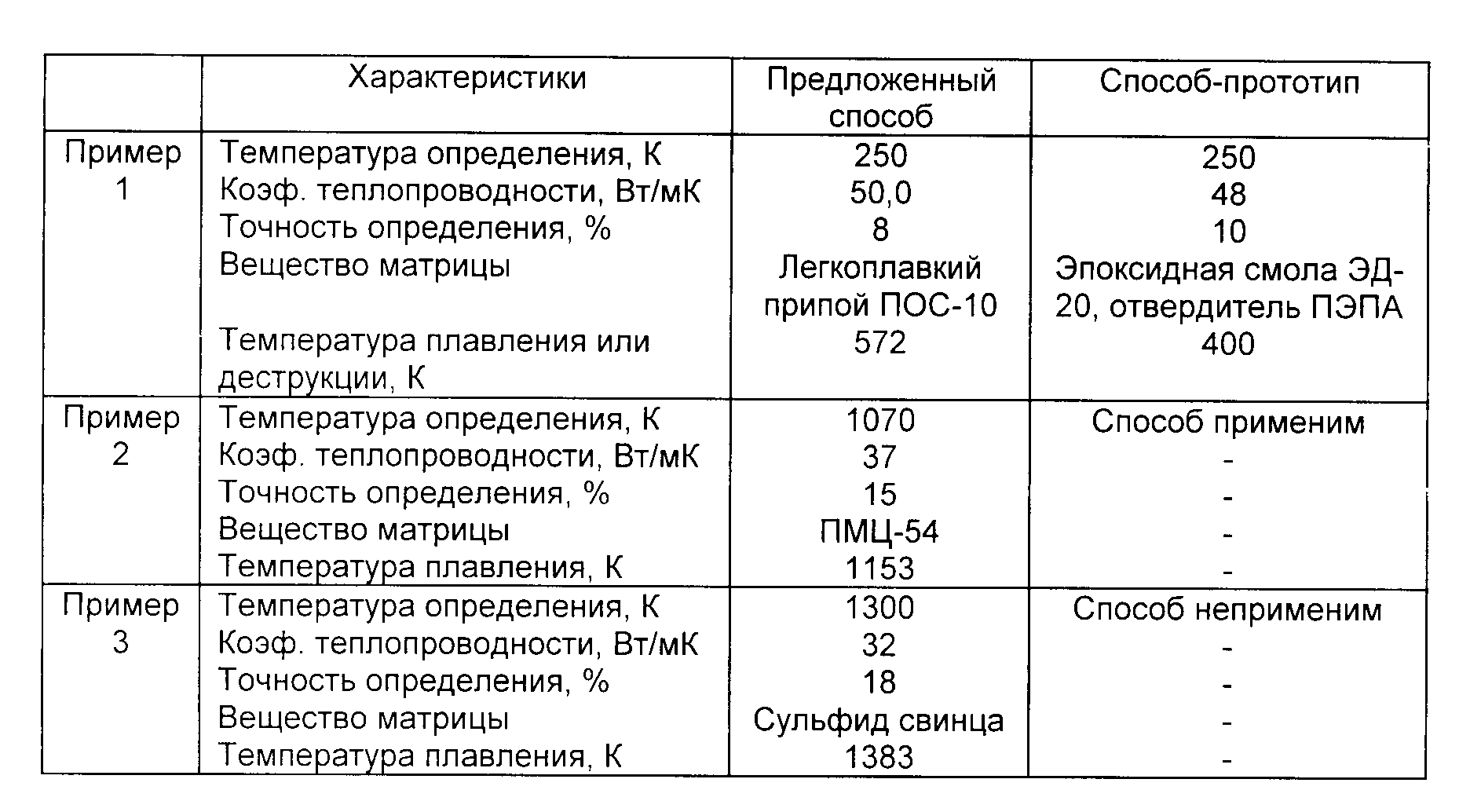How to work with epoxy
To work with epoxy, you will need a hardener, a disposable cup, 2 syringes and a stirring stick.
Instructions for use:
Take a syringe, fill it with the required amount of resin and release it into a glass. Do the same with the hardener. Mixing ratios vary from manufacturer to manufacturer, so read the instructions for use carefully before starting work. An improperly diluted epoxy will not cure well.
Thoroughly mix the resin with the hardener, the mixture should become homogeneous.
It is necessary to mix slowly and carefully, if you do it with sharp movements and quickly, then bubbles will appear in the mass. The liquid consistency of the composition will provide a quick release of bubbles to the outside, they will remain in the initially thick components
The density of the resin depends on the manufacturer. Insufficiently well mixed components will cause poor solidification of the composition.
Polymerization does not occur instantly, it is necessary to wait a little until the mass acquires the consistency required for work.
Pour into a mold or make a lens.
Wait for the time specified by the manufacturer in the instructions for the epoxy to completely cure.
Epoxy resin has conditional hardening stages:
- Initially, the mass is very liquid and runs off easily, which makes it the most suitable for pouring into a mold. The liquid consistency allows the epoxy to penetrate into the smallest depressions, a thicker composition cannot do it, and the relief will not turn out very clear.
- Over time, the epoxy becomes thicker and is suitable for making convex lenses on a flat base. It will not be possible to make such a lens from liquid resin - the composition will roll down from the workpiece. At this stage, it is best to fill in non-embossed forms at home.
- The least suitable consistency of the mix for the job is like thick honey. When picking up epoxy on a stick, bubbles are easily formed, which are very difficult to remove. At this stage, the composition is suitable for gluing the parts together. Epoxy is characterized by excellent adhesion and adheres perfectly to most materials (based on this property, EDP glue was developed.), But easily peels off from polypropylene, polyethylene, silicone, rubber, surfaces covered with a film of fat.
- The epoxy resin becomes very thick and sticky, it is problematic to separate a little from the main mass.
- The next stage is rubber. Epoxy does not stick to your hands, but it easily wrinkles and bends, you can make a lot of products from it, but if you want it to harden in the right position, then fix it, otherwise it will return to its original state.
- Finally cured epoxy. It cannot be pushed through with a fingernail; it feels like plastic to the touch.
Epoxy resin from different manufacturers has different curing times. The time of the onset of the stages is determined exclusively by experience. There is a soft epoxy that remains rubbery even after it has completely cured, which is ideal for some products.
What is epoxy resin for creativity
Today there are more than a dozen types of epoxy resins. They differ in consistency, color, properties, density of epoxy resin and other performance characteristics. Not all of these formulations are used for creativity. Consider the main types of such material.
Characteristics of the popular variety of ED-20 epoxy resin
ED-20 has been considered the most "popular" brand of epoxy for decades. In turn, it is produced in the first and highest grade. The first-class material has a high viscosity and a yellowish color. Its life span is no more than 4 hours. Such a synthetic product is ideal for use in various industries: aircraft, mechanical engineering, shipbuilding, and electrical engineering. Often, ED-20 epoxy is used as a base for adhesives, sealants, potting and impregnating compounds.
 Product made of technical synthetic resin, grade ED-20, first grade. Differs in turbidity and yellowish tint
Product made of technical synthetic resin, grade ED-20, first grade. Differs in turbidity and yellowish tint
Another thing is the highest grade ED-20 epoxy resin, made especially for decorative items. It is characterized by an extreme level of transparency and good viscosity. It is quite simple and pleasant to work with such material. It is this composition that is commonly called epoxy resin for creativity. It is represented on the market by various brands of manufacturers: from foreign to domestic.
epoxy resin ed-20
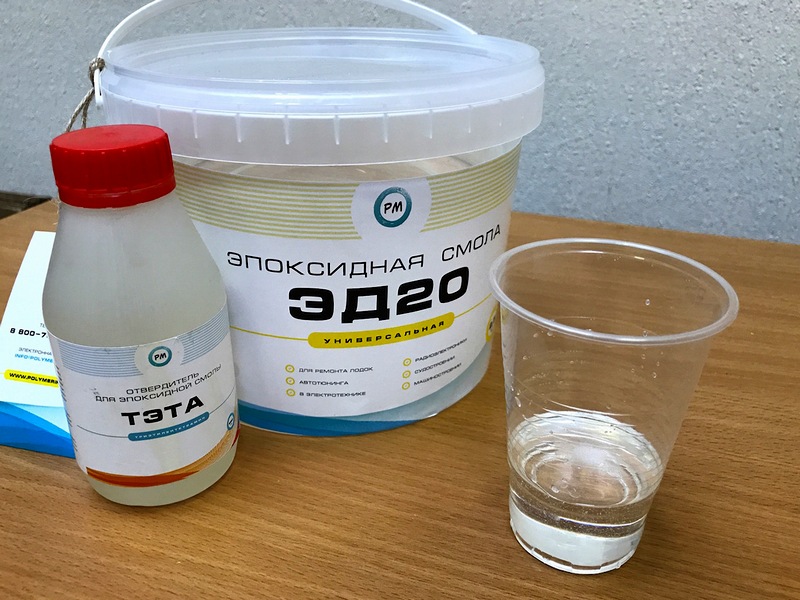 Jewelry compound ED-20
Jewelry compound ED-20
The best jewelry resins are considered to be such brands as Crystal Glass, Viva Dеcor, Epoxy. Depending on how you dilute them, the consistency can be thick or liquid, but the main thing is that the resulting solution itself is bubble-free and perfectly takes any shape. These manufacturers, like others producing jewelry compounds, also work with ED-16, ED-22 resins.
epoxy resin Crystal Glass
Transparent and colored epoxy resin for potting
You look at the work from the compound and you are surprised how beautiful and deep colors they have. Where to buy one, and what is the price of an epoxy resin of this shade? As mentioned above, such a synthetic composition is either transparent or yellowish, which negatively affects the aesthetics of the product.
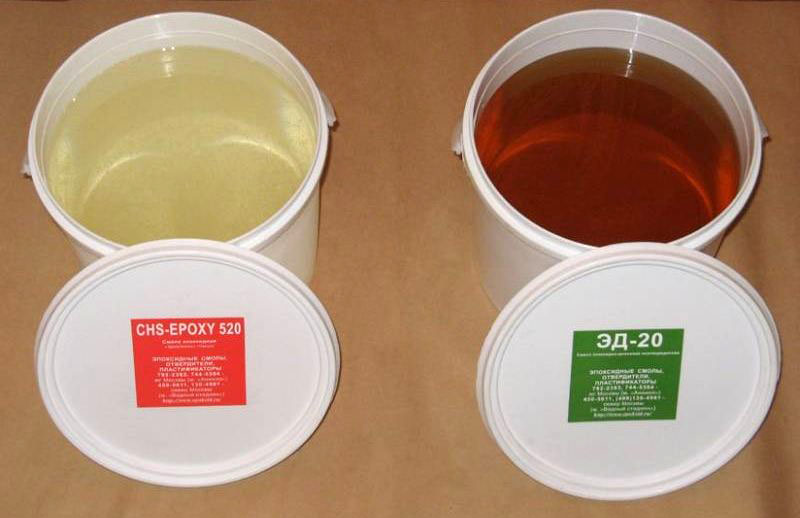 Yellow epoxy
Yellow epoxy
To add decorativeness and design color solutions to synthetic resin products, whole lines of all kinds of pigments and fillers are produced. How bright the shade turns out and evenly mixes the color depends on the properties of the acquired brand of the compound and, undoubtedly, the skill of the "creator" himself. Therefore, only experience and acquired skills will help to achieve the desired results.
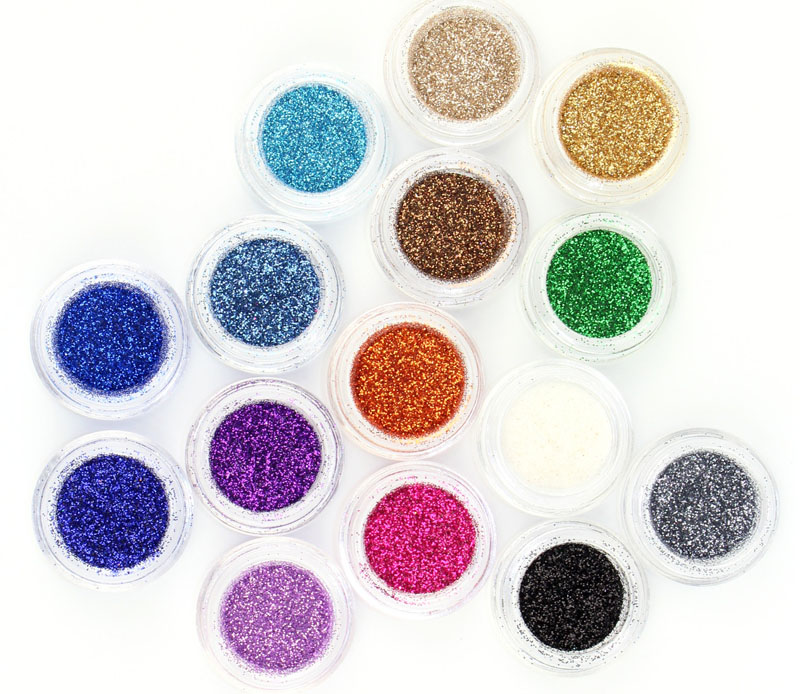 Glitter for epoxy
Glitter for epoxyepoxy glitter
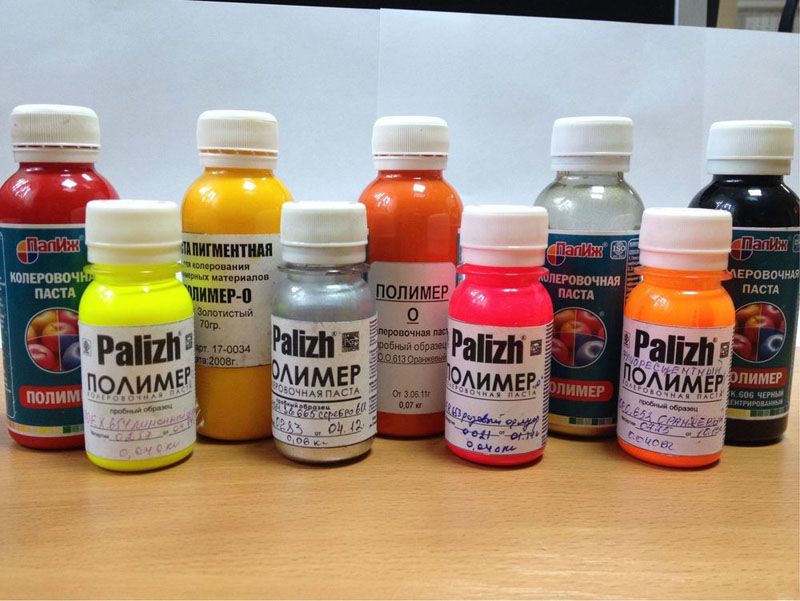 Color for compound
Color for compoundcolor for epoxy
However, relatively recently, such a product for decorating products as soft glass has appeared on the Russian market. It is also often called precisely colored epoxy resin, since the composition is based on just such a synthetic material. It is a kind of colored paste intended to be applied to any surface. When dry, it creates the effect of Marouan glass. Such compositions are very popular when painting glass, creating stained glass windows and other unusual gizmos.
 Soft glass from an Italian manufacturer
Soft glass from an Italian manufacturer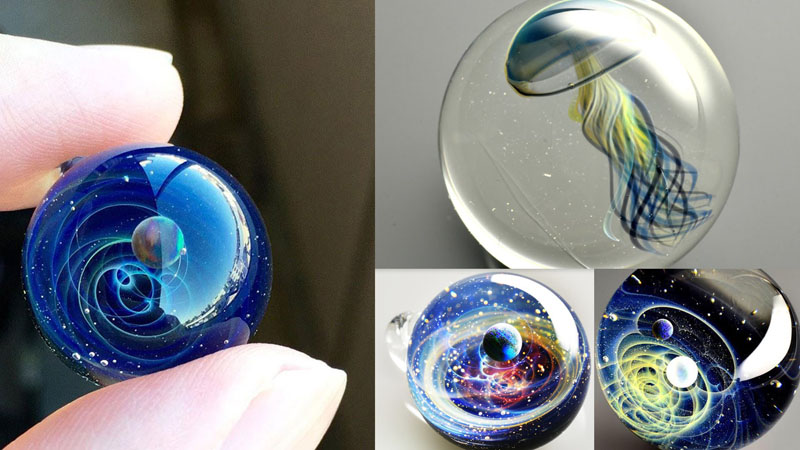 Little Universe from Satisha Tomizu made of soft glass
Little Universe from Satisha Tomizu made of soft glass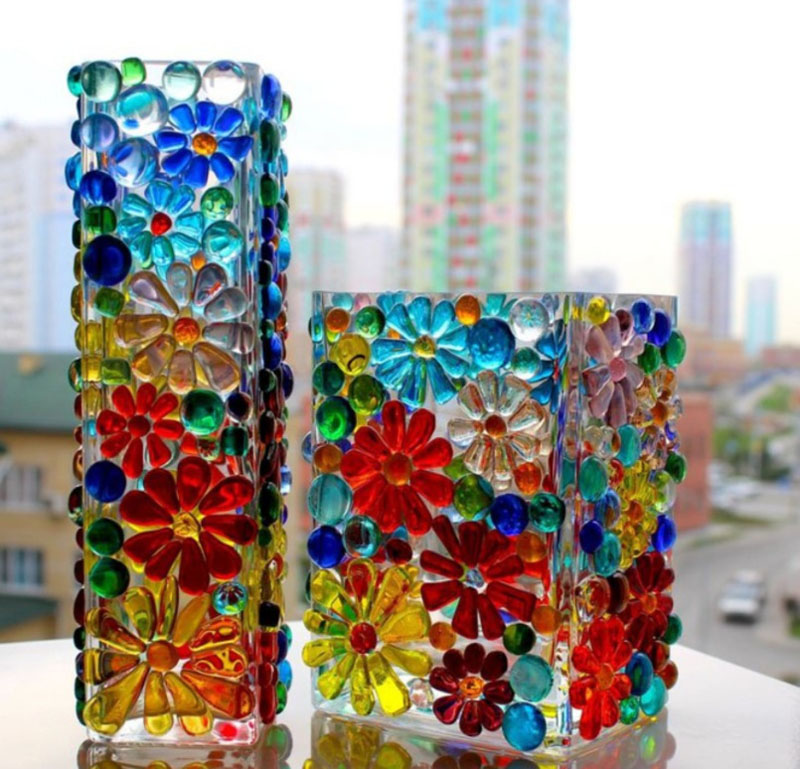 Glass painting
Glass painting
Traditional applications
Shrinkage when using ED-20 gives very little. In addition, as we found out, this agent polymerizes quite quickly. Due to these properties, this material has found a very wide application both in industry and in construction or everyday life. Used resin ED-20, the technical characteristics of which make this tool almost universal, can, for example:
for the repair of all kinds of electric equipment;
-
in instrument making;
-
in the aviation industry;
-
furniture industry;
-
when repairing structural elements of cars;
-
in the radio engineering industry.
This material is also widely used by designers. From it can be created, for example, countertops, haberdashery, all kinds of moisture-resistant products intended for use in bathrooms.Epoxy is also used for priming all kinds of surfaces.
Another area of using ED-20 is the manufacture of enamels, varnishes, putties. Also, using this material, epoxy resins of other brands are made. In everyday life, this material is often used as an adhesive. With its use, it is allowed to fasten both wood and metal, plastic, ceramics, glass.
Epoxy Resin Specifications
Before finding out what temperature the epoxy resin withstands after hardening, it is worth learning about the main technical parameters of this substance. These are the following characteristics:
- the complete polymerization process takes place within 24–36 hours;
- the resin hardening procedure can be accelerated by increasing the temperature regime to + 70⁰С;
- under conditions of low temperatures (up to + 15⁰С), the curing time of the resinous substance decreases;
- when hardening, the epoxy does not shrink and does not expand;
- after hardening, the resin can be subjected to any processing: grinding, polishing, drilling, turning, painting, etc.;
- the recommended operating temperature of epoxy resin is set within the range from -50⁰С to + 150⁰С;
- the maximum allowable temperature during operation is up to + 80⁰С;
- the cured material shows excellent resistance to aggressive influences, including alkalis, solvents and high humidity.

Epoxy is often used for decorative purposes
Epoxy resin has a limited shelf life. It must be used no later than 1.5 years from the date of its release.
Melting temperature of the substance
According to the technical regulations, it was established that the temperature at which the epoxy melts is + 155⁰С. But, given the declared technical characteristics, it is difficult to say that the epoxy will melt. Even heat-resistant epoxy glue or ED-20 epoxy, which is usual for household work, after polymerization, even in ultra-high temperatures, will behave as follows:
- crack;
- foam;
- change its structure without turning into a liquid state (crumbling and breaking).
Some resins (depending on the type of hardener used) can catch fire and produce a lot of soot. The combustion process will continue until the moment of heat replenishment (for example, in an open flame). As soon as the fire source is eliminated, the hardened resin will stop burning.
Despite the ability of the resin to burn, such a substance does not belong to materials with increased fire hazard.
Even when burning, epoxy is much safer than many other artificial substances. For example, foam or expanded polystyrene. Therefore, it makes no sense to talk about what temperature the epoxy glue can withstand until it melts. Almost always, the cured epoxy does not melt, but collapses, turning into a charred, shapeless mass.
Are there fast-setting resins
All epoxies are classified into two major groups. These are structural resins and decorative (or jewelry) resins. Decorative epoxies are characterized by transparency and faster cure times. They are used mainly for design work for the manufacture of souvenir products.
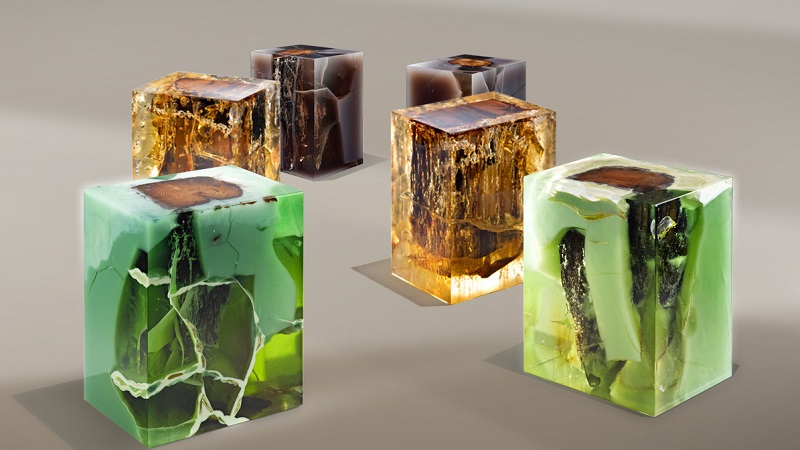
Decorative resins have a faster curing time
Permissible operating temperature of finished products
Technical regulations adopted certain standards for the operation of products and repaired things, when working with which epoxy resin was used. These are the following indicators:
- constant temperature: from -40⁰С to + 120⁰С;
- maximum permissible: from -40⁰С to + 150⁰С.
But some brands of epoxy, according to manufacturers' estimates, have different characteristics. For example, such extreme (maximum permissible) indicators:
Such epoxy substances are specific.Many professionals consider them not even to be epoxy, but to epoxy-silicon-organic. The additional inclusion of silicon creates an increased resistance of substances to thermal effects.
Elevated temperature
During this process, heat is released, which leads to polymerization in general. In this case, the temperature indicators of the substance can reach 100 degrees. Such indicators are more common for large masses of polyester resin dilution. The largest temperature rise is observed during bulk ebb. When a lot of resin is used for casting the floor, the increase will be less high, due to the area in contact with air, self-cooling will occur faster.
If the temperature exceeds the permissible limits, then you can resort to placing the container in cold water, but it should be borne in mind that polymerization will slow down. Temperature indicators above room temperature accelerate the gelatinization stage, and then accelerate the curing. The hardening first passes into the stage of formation of a rubbery consistency, in this form, when pressed, the resin bends, but quickly returns to its original form. Until this moment, the standard time passes 1.5-2 hours.
For hot stages, 50% benzoyl peroxide on dibutyl phthalate is recommended. At the same time, temperatures can rise to indicators of 100-130 degrees, these are quite high indicators, and require additional protection of the person conducting the mixing, if dicumyl peroxide is taken as the hardener, then the indicators can reach 160 degrees.
 The temperature indicators of the substance can reach 100 degrees.
The temperature indicators of the substance can reach 100 degrees.
We eliminate the causes and their consequences
When epoxy resin and different types of hardener interact, different substances can be obtained. They vary in strength and elasticity. And also in softness and elasticity. By combining the base material and the hardener in different ways, varying their concentrations, a polymer with different characteristics is obtained.
However, with any combination of constituent components, complete drying of the resin is required before applying subsequent coats to the epoxy resin. The composition does not freeze for several probable reasons. You should understand them in detail in order to prevent difficulties when using the material.
Component proportion error
Insufficient or excessive amounts of hardener will often interfere with the result. The sticky and incompletely hardened layer, which does not "set" for more than a day, will have to be removed. No further coats are applied to wet epoxy.
To obtain a perfect finish, the proportions must be strictly observed. And the increase or lack of any of the components negatively affects the final result.
When reapplying the compound, the ratio of hardener to epoxy should be checked. It is better not to add extra hardener to the ready-made solution. It is more correct to prepare the composition according to the proportions indicated in the instructions.
Incorrectly selected temperature mode
The mixture hardens at room temperature. However, the resulting coating will dry faster if the ambient temperature is increased. The effectiveness of the "setting" of the epoxy resin largely depends on this factor.
In cool weather, the polymerization reaction time increases. That entails an increase in the hardening time of the composition. When the ambient temperature drops by 10 ° C, the polymerization time increases by 10-15 hours.
What should be done? The following tips will help you maintain the desired cure rate:
- curing will be faster if the temperature is maintained. If necessary - at the expense of an external source;
- if the temperature cannot be maintained at the proper level or it is difficult, a hardener designed to work at low temperatures can be initially used to prepare the mixture.
According to those who use epoxy, there are better brands. For certain conditions, it is better to choose the appropriate variant of the substance. AF-2 should be considered the best domestic brands of hardeners "working" at low temperatures. And the slower best hardener is the DTB-2 brand.
Epoxy and hardener do not mix well
The most common mistake that leads to a decrease in the solidification rate of the composition is insufficient mixing of the components. The reason for the lack of quick curing of epoxy resin is not too long and thorough mixing. And this happens due to an incomplete polymerization reaction. After all, it is as a result of this that the form of the liquid substance changes: the resin gives a durable and beautiful solid layer, it ceases to be sticky.
To make a uniform composition, it is necessary to mix the mixture in the correct amounts. The epoxy resin and the selected type of hardener must be mixed thoroughly. It is necessary to carry out mixing until the composition is completely homogeneous. There should be no places in the resulting solution where there will be a clear predominance of one of the components.
If it is planned to add additives or fillers to the composition (for example, silicone filler, which improves the final result), they should be used only after thorough mixing of the mixture.
The situation can be corrected only by removing the unsuccessful layer. A new mixture is being made. And its components are thoroughly mixed and applied to the prepared surface.
Incorrect selection of components
It is best to use a different hardener for each type of epoxy. This will eliminate the risk of long-term solidification of the composition. It also improves the properties of the resulting coating. The same goes for the polyester resin catalyst. It should be selected according to the type of epoxy.
Taking these factors into account when composing a mixture based on epoxy resin, a high-quality coating is obtained. It dries under favorable conditions for no more than one day.
How to speed up the curing of epoxy: useful tips
Some inexperienced masters advise adding more hardener to the resin than the instructions require to speed up the polymerization process. In practice, with this option, the master will only make it worse. If too much catalyst is added to the solution, the quality of the epoxy itself will deteriorate:
- the resin after hardening will become brittle and fragile;
- it may heat up, which will spoil the material;
- when the mass heats up too quickly, it boils and forms many air bubbles (it becomes meaningless to work with it).
Therefore, the most affordable and safe method for accelerating polymerization is to use additional accelerators. Their role can be played by the usual heating of the ambient air. The higher it is, the faster the epoxy will polymerize and cure.
Characteristics of polyester resin
- Mechanical properties. In this parameter, polyester resins are significantly inferior to epoxies. Therefore, mechanical stress and deformation often lead to cracks and delamination in products.
- Adhesive properties. Polyesters have poor adhesion, so they do not work well as an adhesive.
- Shrinkage. Polyester can shrink in volume up to 7-10%. However, the shrinkage process may take time and delamination will not be immediately apparent.
- Water resistance. After curing, the surface has poor waterproofing properties and is permeable to water.
- Shelf life. Polyester has a short shelf life: on average 6 months - 1 year.
- Polymerization. The curing rate of polyesters is significantly faster than epoxies, and usually takes several hours.The drying process can be accelerated using the MEKP catalyst.
- Smell. During curing, the polymer components give off a strong odor.
- Boiling. Polyester polymers are not prone to boiling.
- Durability. Polyesters form a durable coating, but are prone to microcracking, less resistant to impact, less durable than epoxy coatings.
- UV resistant. Polyester surfaces are UV resistant and do not need a topcoat to prevent yellowing or deterioration from sunlight.
- The complexity of the application. The material is quite simple to use and does not require special knowledge and experience.
- Spheres of application. Polyesters are used in cases where low cost and ease of use are more important than strength and durability. For example, in landscape design, plumbing works, auto tuning, etc.
- Price. Polyester resin is 2-3 times cheaper than epoxy.
- Environmental friendliness and safety. Polyesters contain carcinogenic styrene, which gives off a strong unpleasant odor. The resin components are flammable liquids, catalysts are flammable and explosive. But there are resins on the market without styrene and with its reduced content.
What does the hardening time depend on?
The question in the title of this article is so popular for the simple reason that no instruction manual gives you a clear answer to how long an epoxy takes to dry - simply because timing depends on many variables. For beginners, it is imperative to clarify that, in principle, it begins to fully harden only after a special hardener is added to it, which means that the intensity of the process largely depends on its properties.
Hardeners come in many varieties, but one of two is almost always used: either polyethylene polyamine (PEPA) or triethylene tetraamine (TETA). It is not for nothing that they have different names - they differ in chemical composition, and therefore in their properties.
PEPA is a so-called cold hardener, which fully "works" without additional heating (at room temperature, which is usually 20-25 degrees). It will take about a day to wait for solidification. And the resulting craft will withstand heating up to 350-400 degrees without any problems, and only at temperatures of 450 degrees and above will it begin to collapse.
The chemical curing process can be accelerated by heating the composition with the addition of PEPA, but this is usually not advised, because the tensile, bending and tensile strengths can be reduced by up to one and a half times.
TETA works in a slightly different way - it is the so-called hot hardener. Theoretically, hardening will occur at room temperature, but in general, the technology involves heating the mixture somewhere up to 50 degrees - this way the process will go faster.
In principle, it is not worth heating the product above this value, and when bulk objects over 100 "cubes" are ejected, this is strictly prohibited, because TETA has the ability to self-heat and can boil - then air bubbles form in the thickness of the product, and the contours will clearly be violated. If everything is done according to the instructions, then the epoxy craft with TETA will be more resistant to high temperatures than its main competitor, and will have increased resistance to deformation.
The above differences when choosing are as follows: TETA is the only option if you need a product of maximum strength and resistance to high temperatures, and an increase in the pour point by 10 degrees will give a threefold acceleration of the process, but with the risk of boiling and even smoke
If outstanding properties in terms of product durability are not needed and it is not so important how long the workpiece hardens, it makes sense to choose PEPA
The shape of the craft also directly affects the speed of the process.We mentioned above that the TETA hardener tends to self-heating, but in fact this property is also characteristic of PEPA, only on a much smaller scale. The subtlety lies in the fact that such heating requires maximum contact of the mass with itself.
Roughly speaking, 100 grams of the mixture in the form of a perfectly regular ball even at room temperature and using TETA hardens in about 5-6 hours without outside interference, heating itself, but if you smear the same volume of mass with a thin layer over a 10 by 10 square cm, self-heating will not really be and it will take a day or more to wait for full hardness.
Of course, the proportion also plays a role - the more hardener in the mass, the more intensive the process will go. At the same time, those components that you did not think about at all can take part in thickening, and this, for example, grease and dust on the walls of the mold for pouring. These components can spoil the intended shape of the product, therefore degreasing is carried out with alcohol or acetone, but they also need to be given time to evaporate, because they are plasticizers for the mass and can slow down the process.
If we are talking about a decoration or other craft, then inside the transparent epoxy mass there may be foreign fillers, which also affect how soon the mass begins to thicken. It has been noticed that most fillers, including even chemically neutral sand and fiberglass, accelerate the curing process, and in the case of iron filings and aluminum powder, this phenomenon is especially pronounced.
What temperature does the epoxy resin withstand after curing?
Epoxy resins, without which it is difficult to imagine modern high-tech production, often have to work in very harsh conditions. This is increased radiation, and the effect of chemical reagents on epoxy products, and the widest temperature range, from minus 30 to 200 ° C degrees. Moreover, this does not mean a one-time extreme decrease or increase to the specified limits, but the constant effect of such temperatures on the binding material.
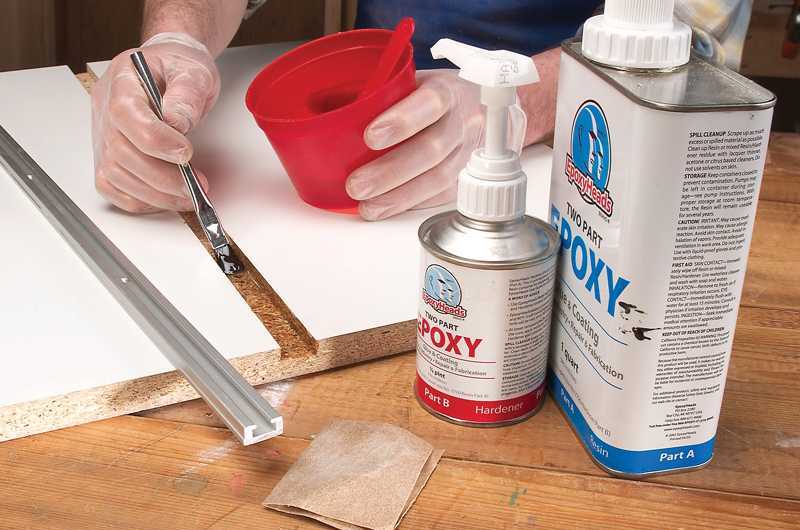
Needless to say, household glue EDP or resin ED-20, ED-22 are not suitable for such temperature changes. Already fully cured, they will first begin to crack, then, depending on the hardener used once, they will foam without passing into the liquid phase, and will begin to break down into small fractions, changing color and structure.
They can also catch fire, again depending on the starting materials and in what form they were polymerized, in the form of a thin coating or a monolith that occupies a certain and large volume in space. Thin epoxy film can ignite and release huge amounts of soot if in direct contact with an open flame. But combustion will continue only until such contact is maintained and there is an intensive replenishment of heat. Move the flame away from the epoxy and it will go out immediately.
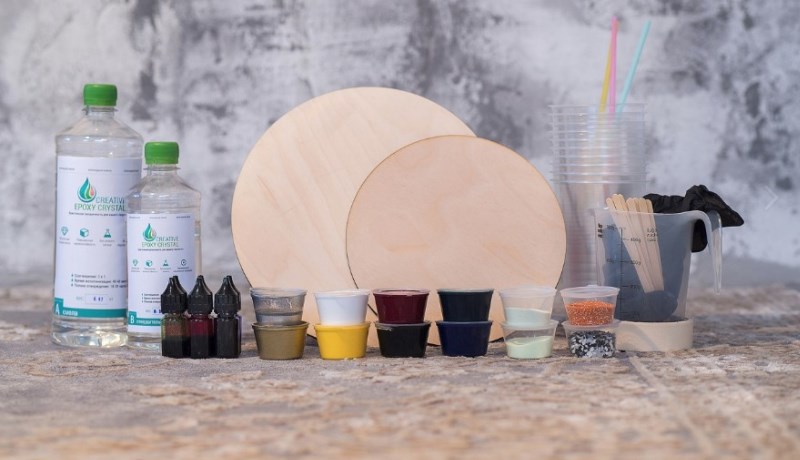
Therefore, it is not worth talking about the fire hazard of using epoxy compounds in everyday life or during repairs. They burn no better than other artificial materials, and much safer than the same foamed polystyrene or polystyrene, remember at least the White Horse nightclub with its many victims from the products of burning ceiling tiles, with the release of phosgene.
Therefore, it makes no sense to talk about some kind of melting temperature of the frozen epoxy resin, in the overwhelming majority of cases it does not melt, but simply collapses, turning into a structureless charred mass.
Drying time for epoxy
Before adding the hardener to the resin, select the optimal ratio of hardener and softener, having previously made small samples. Remember that the reaction between resin and hardener is irreversible. In the event of an error, the material will be damaged.
Polymerization (gelation, gelation) takes some time. For a given mass to turn into a solid state, a reaction must occur, depending on the temperature of the mixture and the proportion of area to mass of resin. Consider how long it takes for epoxy to dry in a silicone mold. For example, for solidification of 100 grams of "epoxy" mixed with PEPA hardener, it takes from 30 to 60 minutes. In this case, the temperature should be + 22 ... + 24оС. With an air temperature of + 15 ° C, the same process will take more than 80 minutes. If at the same temperature (+ 22 ... + 24 ° C) you spread the epoxy mixture on a surface with an area of 1 m2, then the polymerization process will take at least 20 minutes.
Therefore, follow the recommendation and mix the resin as much as you can work out before it sets.
If you need to prepare a large amount of a substance, it is recommended to divide it into smaller portions immediately after mixing. Otherwise, you will not have time to work out the estimated surface area.
The rate of how much epoxy dries depends on the initial temperature, but the curing mechanism itself does not depend on it.
It is noted that the reaction of the mixture in the liquid state is faster. In the course of polymerization, the resin changes from a liquid state to a viscous gel. Gradually hardening, it is sticky. In the course of increasing hardness (solidification), the reaction rate begins to slow down, accompanied by a gradual loss of stickiness.
How long does epoxy with hardener and fiberglass dry? Final hardening occurs in 24 hours if the air temperature fluctuates in the range of + 22 ... + 24 ° C. But this does not guarantee 100% strength. A day later, this figure will be only 65-70%. It is possible to additionally increase the hardness of the material by using the same PEPA and heat treatment at a temperature of + 60 ... + 100 ° C for 1-12 hours. Then the epoxy acquires the highest strength.

